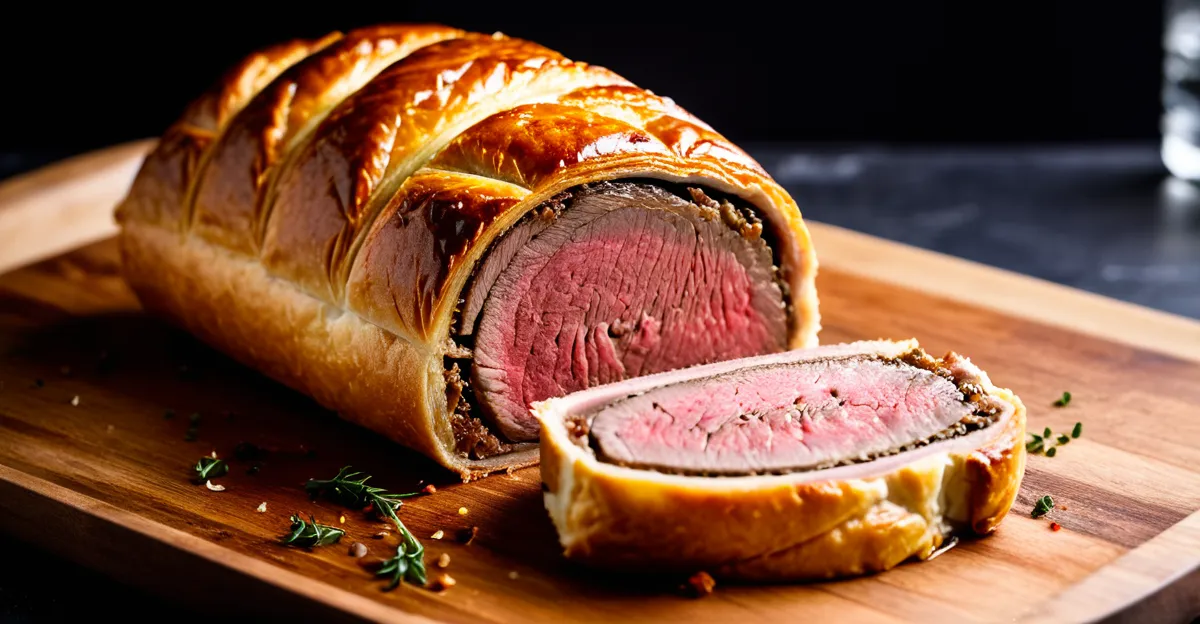Classic Beef Wellington: Ingredients and Preparation Steps
Unraveling the foundation of an iconic dish
Mastering a classic beef Wellington begins with assembling the right beef Wellington ingredients. The cornerstone is a center-cut beef fillet, selected for its tender, even texture. Seasoning is crucial; simple salt and pepper enhance natural flavor without overpowering.
In parallel : How do you make a classic British sausage roll from scratch?
The preparation steps start by searing the beef fillet rapidly to seal in juices, a critical move to keep it succulent inside the pastry. Next comes the duxelles—a fine mushroom mixture cooked down to earthy richness—which is spread evenly over the cooled fillet. Prosciutto slices then wrap the duxelles-covered fillet to provide a delicate, salty layer enhancing both moisture retention and flavor depth.
After these layers, the entire assembly is enveloped in puff pastry. This final covering encases the beef Wellington ingredients, creating a flaky, golden shell after baking. Precision in wrapping ensures the puff pastry seals completely around the filling to prevent leaks and maintain structural integrity during cooking.
Also to discover : What Are the Unique Features of Traditional British Cooking?
These carefully choreographed step-by-step recipe preparation steps guarantee the iconic blend of textures and flavors that define a traditional beef Wellington.
Techniques for Perfect Execution of Classic Beef Wellington
Ensuring flawless results with expert methods
Mastering beef Wellington techniques centers on proper pastry wrapping and sealing. After layering the fillet with duxelles and prosciutto, the puff pastry must fully encase the filling with tight, seamless edges. This precise sealing prevents juices from escaping during baking, preserving the meat’s juiciness and avoiding soggy pastry.
Achieving an even golden crust requires chilling the wrapped Wellington before baking. This rests the pastry, helping it retain shape and promoting a flaky texture. Preheating the oven to the correct temperature and baking on the middle rack assures uniform heat circulation, so the puff pastry browns perfectly without burning.
Regarding beef doneness, searing the fillet first locks in moisture, but monitoring internal temperature during or after baking is vital. For a medium-rare center, aim for around 55°C (130°F). After baking, resting the beef Wellington for 10-15 minutes allows juices to redistribute, resulting in a tender slice and clean presentation.
Applying these cooking tips with careful attention to sealing and temperature control elevates this classic dish from good to exceptional every time.
Substitutions, Cooking Tips, and Visual Guidance
Simplifying preparation with practical alternatives
Exploring beef Wellington tips enriches your cooking experience, especially when traditional ingredients are unavailable or dietary needs arise. For instance, if pork-based prosciutto is unsuitable, alternatives like thinly sliced turkey or vegetarian ham can maintain the necessary moisture barrier and flavor. Similarly, swapping classic mushrooms in the duxelles for shiitake or chanterelle offers unique earthy notes without compromising texture.
A solid grasp of ingredient substitutions ensures flexibility without losing the dish’s essence. One helpful beef Wellington tip is using high-quality frozen puff pastry for convenience, which can yield flaky results comparable to fresh pastry when properly thawed and handled cool.
Visual aids are invaluable. Consulting step-by-step visuals—whether photos or instructional videos—clarifies crucial moments like pastry sealing or evenly spreading duxelles. These resources complement written preparation steps, reducing mistakes and boosting confidence during execution.
Finally, consistent results stem from simple cooking tips like avoiding overhandling pastry, ensuring even oven heat, and resting the Wellington after baking. Combined, these strategies support both beginners and experienced cooks in crafting a perfect beef Wellington every time.
Modern Twists on the Classic Beef Wellington
Refreshing tradition with innovative flair
Exploring modern beef Wellington introduces exciting beef Wellington variations that cater to diverse tastes and dietary preferences. One popular approach is incorporating alternative proteins such as lamb or venison, which offer a rich depth contrasting the traditional beef fillet. Vegetarian or vegan adaptations replace meat with hearty mushrooms, cauliflower steaks, or legumes, maintaining the iconic layered structure.
Innovative ingredients elevate flavor complexity. Adding herbs like tarragon or rosemary complements the earthy duxelles, while specialty mushrooms such as chanterelle or porcini bring unique aroma and texture. Some cooks enhance moisture retention and aroma by integrating foie gras or a thin crepe beneath the prosciutto layer, blending tradition with luxury.
Presentation has also evolved. Modern plating techniques focus on clean slices showcasing defined layers while garnishing with microgreens or a delicate sauce drizzle for visual and palate appeal. These modern beef Wellington updates respect the classic’s essence while inviting creativity, making the dish both impressive and adaptable. This embraces evolving culinary trends without sacrificing the foundational preparation steps and attention to quality, ensuring the Wellington remains a standout centerpiece at any occasion.




